Southern Chinese City Battles Chikungunya Virus Outbreak with Fish, Drones, and Surveillance Techniques
In the bustling industrial city of Foshan, Guangdong Province, China, a significant public health event has unfolded. An outbreak of Chikungunya fever, a mosquito-borne virus, has been reported with over 8,000 confirmed cases since July 2025 [1][3]. This marks the first major outbreak of Chikungunya in China, involving sustained local transmission primarily due to increased presence of Aedes mosquitoes and lack of population immunity [1][3].
Transmission and Symptoms
Chikungunya virus (CHIKV) is spread by Aedes mosquitoes, which thrive in the Foshan area’s environment. The virus causes symptoms including fever, joint pain, and rash [2]. Genomic analysis of virus samples from the outbreak showed the strains belong to the Central African Clade of the East-Central-South African genotype [2]. Human cases are infectious to mosquitoes during the early symptomatic period, enabling local transmission cycles.
The symptoms reported in Foshan include fever (86.8%), joint pain (81.4%), and rash (65.5%), with no severe illness or deaths documented so far [2]. All cases have been confirmed by RT-PCR and viral genome sequencing for surveillance [2].
Control Measures
To combat the outbreak, a multi-layered containment strategy has been implemented. This includes aggressive mosquito control, patient-level interventions, surveillance and diagnostics, and enforced measures [1][2][3].
- Vector control: Drone-based fogging, fines for noncompliance, use of mosquito-eating fish, and elimination of mosquito breeding sites within 100 meters of case locations [1][3].
- Patient-level interventions: Insecticide-treated window screens, bed nets, and residual repellents applied at patients’ homes to prevent mosquito bites and interrupt transmission [2].
- Surveillance and diagnostics: Active case detection and differential screening from dengue, routine nucleic acid testing implemented in healthcare settings to identify and manage cases promptly [2].
- Enforced measures: Quarantines and household inspections reminiscent of prior COVID-19 responses have been instituted to ensure compliance with mosquito control efforts [1].
Current Status
As of the latest reports, the outbreak has primarily affected the population of Foshan and nearby areas [1][3]. Given the lack of prior immunity to the Chikungunya fever in the population, authorities are closely monitoring the situation.
Side Note
On a separate note, it has been observed that the user's browser or ad blocker is currently preventing the execution of JavaScript on NZZ.ch. While no further information is provided about optimizing browser settings in this context, it is advisable to adjust settings to enable JavaScript on NZZ.ch for optimal functionality.
In summary, the Foshan chikungunya outbreak is a significant public health event, prompting a multi-layered containment strategy combining vector control, active surveillance, and patient-focused protective measures [1][2][3].
- Employees in the Foshan workplace-wellness sector should be made aware of the Chikungunya outbreak and its symptoms.
- Science has played a crucial role in identifying the Chikungunya virus and understanding its transmission.
- With over 8,000 confirmed cases, it's essential for individuals to prioritize sleep to boost their immune systems.
- The outbreak has highlighted the importance of workplace-wellness programs in managing medical-conditions like Chikungunya.
- Chronic diseases and cancer might weaken the body's ability to fight off infections such as Chikungunya.
- Respiratory conditions, digestive-health issues, and eye-health problems can be exacerbated by the stress and discomfort brought on by the outbreak.
- Hearing loss or impairment can potentially affect one's ability to receive important public health updates regarding the Chikungunya outbreak.
- Health-and-wellness clinics should ensure their patients are informed about the outbreak and receive appropriate care if affected.
- Fitness-and-exercise routines can help strengthen the immune system and improve overall health during the Chikungunya outbreak.
- Sexual-health services should remind patients to practice safe sex to avoid transmitting potentially harmful diseases.
- Autoimmune-disorders can make individuals more susceptible to viruses like Chikungunya.
- Climate change can facilitate the growth of mosquito populations, increasing the risk of future Chikungunya outbreaks.
- Manufacturing industries should implement stricter sanitation practices to prevent mosquito breeding within their facilities.
- Mental-health professionals should be prepared to address any anxiety or stress related to the Chikungunya outbreak.
- Mens-health issues, such as prostate conditions, can affect the body's response to infections like Chikungunya.
- Skin-care practices, including the use of CBD, may help protect against Chikungunya-related skin-conditions.
- Therapies-and-treatments for Chikungunya symptoms are being developed and tested to provide relief for those affected.
- Nutrition plays a vital role in maintaining a strong immune system, thus helping the body combat Chikungunya and other infections.
- Aging may contribute to a weaker immune system, making older individuals more at risk for Chikungunya and similar diseases.
- Womens-health services should incorporate Chikungunya education and preventive measures into their regular care.
- Parenting resources should educate parents on Chikungunya and how to protect their children during the outbreak.
- Weight-management programs can help individuals maintain a healthier lifestyle, reducing the risk of complications from Chikungunya.
- Cardiovascular-health is essential for the body to effectively circulate blood and fight off infections like Chikungunya.
- Industry leaders must collaborate to develop effective control measures against future Chikungunya outbreaks.
- Medicare recipients should be made aware of their coverage options for Chikungunya-related treatments.
- Neurological-disorders can complicate the diagnosis and treatment of Chikungunya.
- Environmental-science research plays a key role in understanding the factors contributing to Chikungunya outbreaks.
- In the realm of finance, investments in research, healthcare infrastructure, and clean energy solutions can help combat future Chikungunya outbreaks and other health-related challenges.




